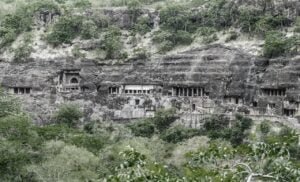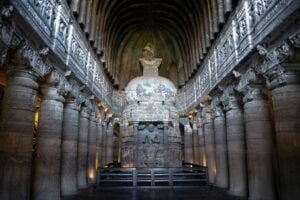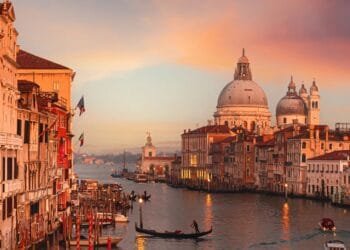The Ajanta Caves, located in the Aurangabad district of Maharashtra state in India, are a mesmerizing collection of 29 rock-cut Buddhist cave monuments. Dating back to the second century BCE to about 480 CE, these caves are not only a UNESCO World Heritage Site but are also universally regarded as masterpieces of Buddhist religious art.
The Ajanta Caves are a testament to the rich cultural and artistic heritage of ancient India. They showcase intricate paintings and rock-cut sculptures that are considered among the finest surviving examples of Indian art. One of the most remarkable aspects of these caves is the expressive paintings that vividly portray emotions through gestures, poses, and forms.
Built in two phases, the first phase of construction began around the second century BCE, while the second phase took place between 400 and 650 CE. These caves served as ancient monasteries (Viharas) and worship-halls (Chaityas) for different Buddhist traditions. Carved into a 75-meter wall of rock, the Ajanta Caves offer a glimpse into the spiritual and artistic practices of ancient India.
The caves also feature paintings that depict the past lives and rebirths of the Buddha, as well as pictorial tales from Aryasura’s Jatakamala. Additionally, visitors can marvel at the rock-cut sculptures of Buddhist deities, which add to the overall grandeur of the site.

Historical records suggest that the Ajanta Caves served as a monsoon retreat for monks and provided a resting site for merchants and pilgrims in ancient India. While vivid colors and mural wall paintings were abundant in Indian history, the Ajanta Caves, specifically Caves 1, 2, 16, and 17, house the largest corpus of surviving ancient Indian wall-paintings.
The significance of the Ajanta Caves extends beyond India, as they are mentioned in the memoirs of several medieval-era Chinese Buddhist travelers. These caves remained hidden in the dense jungle until they were accidentally discovered by a colonial British officer, Captain John Smith, during a tiger-hunting expedition in 1819. Since then, they have captivated the attention of the Western world.
Nestled within the rocky northern wall of the U-shaped gorge of the river Waghur, the Ajanta Caves offer a truly awe-inspiring experience. The sound of waterfalls cascading within the gorge adds to the enchanting ambiance, especially during the monsoon season.
Together with the Ellora Caves, the Ajanta Caves are one of the major tourist attractions in Maharashtra. Located approximately 59 kilometers (37 miles) from the city of Jalgaon, 104 kilometers (65 miles) from Aurangabad, and 350 kilometers (220 miles) east-northeast of Mumbai, Ajanta is easily accessible to visitors. It is also worth noting that the Ellora Caves, which contain Hindu, Jain, and Buddhist caves, are just 100 kilometers (62 miles) away from Ajanta.

The Ajanta style of art can be found not only in the Ellora Caves but also in other sites such as the Elephanta Caves, Aurangabad Caves, Shivleni Caves, and the cave temples of Karnataka. This artistic style has left an indelible mark on the cultural landscape of India.
A visit to the Ajanta Caves is a journey back in time, where one can immerse themselves in the rich history and artistic brilliance of ancient India. The intricate paintings, awe-inspiring sculptures, and serene surroundings make it a must-visit destination for art enthusiasts, history buffs, and spiritual seekers alike.
So, plan your trip to the Ajanta Caves and embark on an unforgettable adventure that will transport you to a bygone era of artistic excellence and spiritual enlightenment.



























